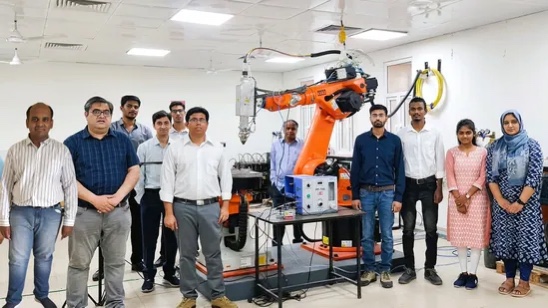The Indian Institute of Technology (IIT) Jodhpur recently announced that the university has developed a new directed energy deposition (DED) metal printing system. Aside from the machine’s laser, as well as a robotic arm manufactured by Germany-based robotics company KUKA, every component of the machine was made in India.

This is perhaps the most notable example to date of the National Strategy on Additive Manufacturing (NSAM), a program announced by India’s government earlier this year. One of the stated goals of the program is to create “50 Indian [AM] technologies”, including materials, printers, post-processing, and software. Overall, the NSAM is the latest component in Prime Minister Modi’s Atmanirbhar Bharat (“Self-Reliant India”) policy, which his administration has pursued since it began in 2014.
In a press release, one of the engineers who worked on the project, Dr Ravi KR, said, “The small success of this research has given great hope to our team to undertake new endeavors. Moreover, it will further strengthen the trust placed on our team and organization by the funding agencies and industry that are assisting our current research and will be assisting us in the future.” Another member of the team, physicist V Narayanan, noted that the machine can print parts using domestically-sourced metal powders, and explained, “Our team has developed this machine’s tool path, planning software, and coaxial nozzle. It also has in-situ monitoring technologies which constantly monitor the melt pool temperature and clad thickness during the [AM] process.”
Dr Ravi KR — who is an associate professor at IIJ Jodphur’s department of metallurgical and materials engineering — also said that the overall cost of the machine could be reduced by two to three times by sourcing all the materials from within India. Although there are already other metal 3D printers manufactured in India, this is the first one designed with the objective of relying almost entirely on domestic supply chains.
The idea is an especially interesting one concerning metal AM, specifically, since the creation of wholly domestic supply chains could eventually be leveraged into optimizing the number of printer parts that can themselves be printed. Obviously any remotely successful attempt at achieving such an objective would take years. However, any nation that accomplishes it will have created a truly self-reliant supply chain.
Additionally, India would be the logical place to do that. As I’ve noted in my coverage of the nation’s AM sector going back to last October, the country seems poised to be the central hub in a plan to create an alternative to China’s Belt and Road Initiative. This seems to be increasingly likely, given the G7’s announcement yesterday that the group is planning a $600 billion alternative to Belt and Road.
Images courtesy of IIT Jodhpur